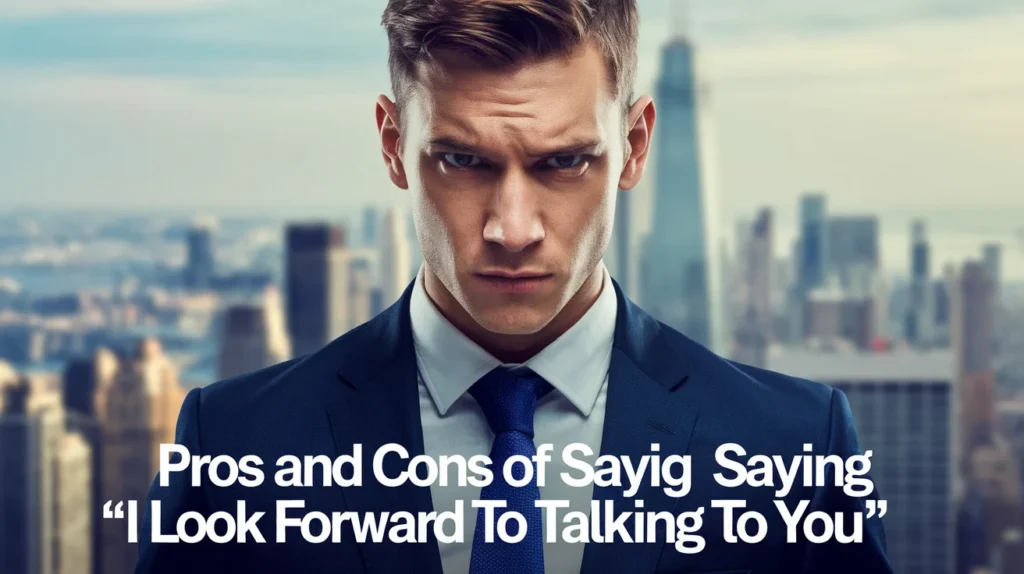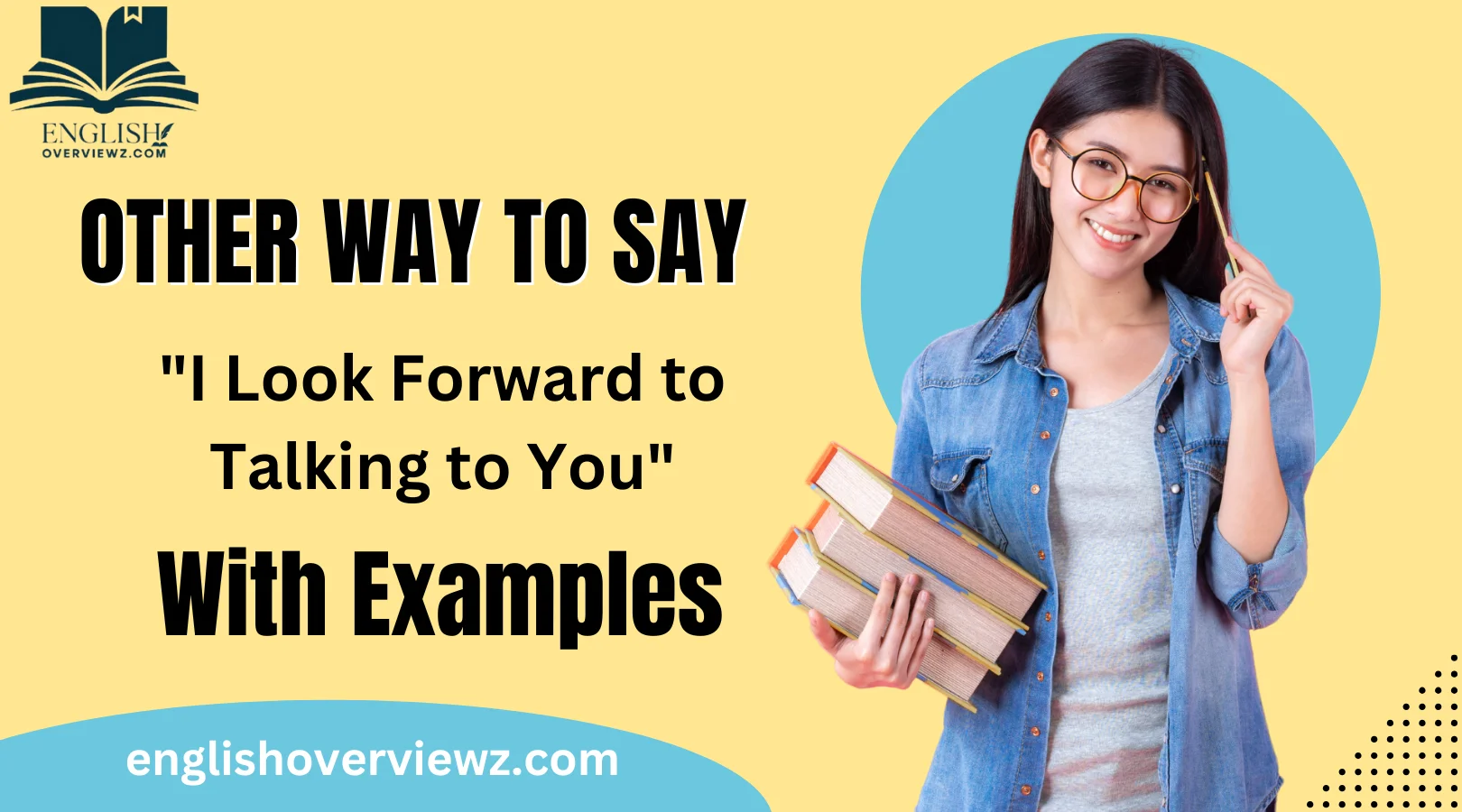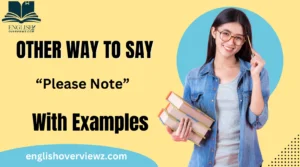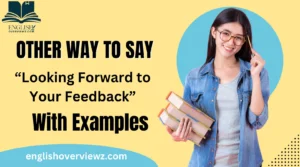Have you ever found yourself trying to wrap up a conversation or email and wondering how to express that you’re excited or eager to chat again? It’s common to fall back on the phrase “I look forward to talking to you,” but there are so many other ways to say it that can make your message sound more personal and thoughtful.
In this article, we’ll dive into 20 other ways to express the same sentiment, all with a little extra warmth, care, and flair. Whether you’re writing to a colleague, a client, or a friend, these alternatives will help you sound both professional and personable.
What Does “I Look Forward to Talking to You” Mean?
When you say, “I look forward to talking to you,” you’re expressing excitement and anticipation for a future conversation. It’s a polite and warm way to show you’re eager to continue a discussion. This phrase is often used to signal enthusiasm for an upcoming meeting, call, or email exchange, making the other person feel valued and heard. But sometimes, a little variety in phrasing can make your message feel more engaging and less repetitive.
Is It Professional/Polite to Say “I Look Forward to Talking to You”?
In most professional and casual situations, “I look forward to talking to you” is perfectly polite and professional. It’s a positive way to end an email or conversation, signaling your eagerness for the next interaction. However, there might be times when you’d want to sound a bit more creative or specific to the situation.
Using an alternative phrasing can convey the same excitement, but with a slightly different tone, whether you’re aiming for something formal, friendly, or even a bit playful.
Pros and Cons of Saying “I Look Forward to Talking to You”

Pros:
- Personal Connection: It’s a friendly and warm way to signal that you value the other person’s time and input.
- Polite & Professional: It’s a safe phrase to use in emails, particularly in professional settings.
- Clear Intentions: It communicates eagerness and lets the other person know you’re invested in the conversation.
Cons:
- Overused: This phrase can become repetitive if you use it too often.
- Too General: It might not convey the exact tone or enthusiasm you want for every situation.
Synonyms for “I Look Forward to Talking to You”
- I Can’t Wait to Chat Soon
- Looking Forward to Our Discussion
- Excited to Hear Your Thoughts
- Can’t Wait to Connect Again
- Looking Forward to Catching Up
- Eager to Hear from You
- Can’t Wait to Hear More
- I’m Excited About Our Conversation
- Looking Ahead to Our Talk
- Eager to Catch Up
- Can’t Wait to Speak With You
- Excited About Our Chat
- I’m All Set for Our Conversation
- Counting Down to Our Talk
- I’m Ready for Our Discussion
- Looking Forward to Exchanging Ideas
- Excited to Connect
- Looking Forward to Speaking Soon
- Can’t Wait to Catch Up Again
- Eager for Our Next Conversation
1. “I Can’t Wait to Chat Soon”
This alternative has a more informal, excited vibe, signaling that you’re eagerly anticipating your next conversation.
Scenario Example:
Hi Sarah,
Thanks for your insights on the project! I can’t wait to chat soon to discuss the next steps. Have a great day!
Best,
[Your Name]
Best Use: This is ideal when you’re speaking with friends or colleagues you have an established relationship with. It’s friendly and genuine.
Additional Notes: It’s a great choice if you want to sound more enthusiastic and less formal.
2. “Looking Forward to Our Discussion”
This phrase keeps things professional but still expresses enthusiasm for the upcoming talk. It’s ideal for formal emails or client interactions.
Scenario Example:
Dear John,
Thank you for scheduling the meeting tomorrow. Looking forward to our discussion on the new project.
Best regards,
[Your Name]
Best Use: This works well in professional settings where you want to sound courteous yet interested in the upcoming conversation.
Additional Notes: It’s a good way to show anticipation without sounding too casual.
3. “Excited to Hear Your Thoughts”
If you want to express anticipation while keeping the focus on the other person’s ideas or input, this is a great choice.
Scenario Example:
Hi Emily,
Thanks for sharing the initial draft with me. Excited to hear your thoughts on the next version.
Best,
[Your Name]
Best Use: This is a great option for professional and creative environments where you value the other person’s feedback.
Additional Notes: It’s perfect when you want to focus on the upcoming conversation’s content rather than just the talk itself.
4. “Can’t Wait to Connect Again”
This phrase implies a more informal connection, great for colleagues or friends you chat with often. It feels warm and friendly.
Scenario Example:
Hey Mark,
That was a great chat earlier today. Can’t wait to connect again tomorrow to dive deeper into the project.
Cheers,
[Your Name]
Best Use: Ideal for informal situations or when you have a casual, ongoing dialogue with someone.
Additional Notes: It’s less formal than some other options, so use it with people you have a friendly rapport with.
5. “Looking Forward to Catching Up”
If you’re talking to someone you haven’t spoken to in a while, this phrase gives a sense of reconnecting.
Scenario Example:
Hi Jessica,
It’s been too long since we last caught up! Looking forward to catching up with you on the new updates soon.
Best,
[Your Name]
Best Use: Perfect for reconnecting with colleagues or friends after a gap in communication.
Additional Notes: It gives a sense of familiarity and friendliness, making it ideal for casual conversations.
6. “Eager to Hear from You”
This phrase is great when you’re waiting for the other person’s thoughts or response.
Scenario Example:
Hi Alex,
I’ve sent over the document for your review. Eager to hear from you about your thoughts and suggestions.
Best,
[Your Name]
Best Use: This works well in situations where you’re expecting feedback, such as after sending documents or proposals.
Additional Notes: It’s a professional yet friendly way to show you’re awaiting the other person’s input.
7. “Can’t Wait to Dive Deeper Into This”
This one is great for when you’re discussing something in-depth, such as a project or brainstorming session.
Scenario Example:
Hi Chris,
Thanks for your initial thoughts on the idea. Can’t wait to dive deeper into this and flesh it out together.
Best,
[Your Name]
Best Use: Use this when you’re excited to explore a topic more thoroughly with someone, especially in a collaborative or creative context.
Additional Notes: It’s an engaging way to indicate that the conversation will be detailed and productive.
8. “I’m Looking Forward to Hearing Your Insights”
This alternative shows respect for the other person’s expertise and signals that you value their input.
Scenario Example:
Hi Kate,
I appreciate your time in reviewing the proposal. I’m looking forward to hearing your insights on how we can improve it.
Best regards,
[Your Name]
Best Use: This is a great choice when you’re speaking to someone whose opinions or expertise you value, like a mentor or senior colleague.
Additional Notes: It’s a respectful and professional way to indicate that you’re eager to hear their thoughts.
9. “Can’t Wait to Touch Base”
This one feels a little more casual and is ideal for quick follow-up chats or meetings.
Scenario Example:
Hey Ben,
Thanks for setting up the call. Can’t wait to touch base with you tomorrow and finalize the details.
Cheers,
[Your Name]
Best Use: Perfect for casual follow-ups or quick meetings, particularly in ongoing projects.
Additional Notes: This phrase is less formal and works well when you don’t need to convey too much formality.
10. “I’m Excited to Continue Our Conversation”
This phrase shows that you enjoyed the first conversation and are eager to keep it going.
Scenario Example:
Hi Rachel,
It was great discussing the new project earlier today. I’m excited to continue our conversation and explore more ideas tomorrow.
Best,
[Your Name]
Best Use: Ideal when you’ve had a productive discussion and want to build on it in the future.
Additional Notes: It’s a warm, engaging way to show your interest in a follow-up conversation.
6. “Eager to Hear from You”
If you want to gently nudge someone while showing genuine interest in their response, this is your go-to phrase.
Scenario Example:
Hi Alex,
I’ve sent over the document for your review. Eager to hear from you about your thoughts and suggestions.
Best,
[Your Name]
Best Use: Perfect when you’re awaiting feedback or input and want to sound polite yet enthusiastic.
Additional Notes: It works nicely as a reminder without sounding pushy. Use it when you want to encourage a response with warmth.
7. “Can’t Wait to Hear More”
This one adds an extra splash of excitement! It shows that you’re genuinely interested in continuing the conversation.
Scenario Example:
Hi Dana,
Your ideas in the last meeting were really inspiring. Can’t wait to hear more in our upcoming call!
Cheers,
[Your Name]
Best Use: Ideal when you want to express curiosity and excitement about the other person’s insights.
Additional Notes: Great for brainstorming sessions or creative collaborations.
8. “I’m Excited About Our Conversation”
A straightforward and cheerful way to express genuine enthusiasm about the upcoming chat.
Scenario Example:
Dear Mr. Thompson,
Thank you for scheduling the call. I’m excited about our conversation and the chance to explore potential collaborations.
Best regards,
[Your Name]
Best Use: Perfect for first-time calls or when you want to sound energetic yet professional.
Additional Notes: It strikes a nice balance between professional and enthusiastic.
9. “Looking Ahead to Our Talk”
This version feels a bit more reflective, as if you’re thoughtfully anticipating the chat.
Scenario Example:
Hi Grace,
I appreciate you setting aside time this week. Looking ahead to our talk and catching up on progress!
Warmly,
[Your Name]
Best Use: Works well in professional emails, especially when you’re confirming a scheduled conversation.
Additional Notes: It adds a thoughtful tone that shows you value the upcoming discussion.
10. “Eager to Catch Up”
This is a friendly and easygoing way to show you’re excited about the next conversation.
Scenario Example:
Hey Chris,
It’s been a busy month! Eager to catch up and hear how everything’s going on your end.
Talk soon,
[Your Name]
Best Use: Best for casual or semi-formal exchanges with colleagues or friends.
Additional Notes: It feels natural and relatable, like chatting with a friend.
11. “Can’t Wait to Speak With You”
Simple yet full of energy, this phrase keeps things natural and direct.
Scenario Example:
Hi Rebecca,
I’ve really enjoyed our email exchange. Can’t wait to speak with you tomorrow and dive deeper into the details!
Best,
[Your Name]
Best Use: Great for both personal and professional contexts when you want to sound genuine and warm.
Additional Notes: It’s a nice middle-ground phrase — not too formal, not too casual.
12. “Excited About Our Chat”
This one feels personal and lighthearted, like you’re genuinely looking forward to a friendly conversation.
Scenario Example:
Hey Taylor,
Thanks for reaching out! Excited about our chat later this week to brainstorm ideas.
Cheers,
[Your Name]
Best Use: Perfect for friendly work environments or informal catch-ups.
Additional Notes: It brings a cheerful and approachable tone to your message.
13. “I’m All Set for Our Conversation”
This shows that you’re not just looking forward to the talk — you’re prepared and ready!
Scenario Example:
Dear Dr. Patel,
Thank you for the agenda. I’m all set for our conversation tomorrow to review the project details.
Warm regards,
[Your Name]
Best Use: Ideal for professional settings when you want to emphasize readiness.
Additional Notes: It adds a proactive, responsible tone to your message.
14. “Counting Down to Our Talk”
This is a playful, lighthearted way to express excitement about the upcoming conversation.
Scenario Example:
Hi Sophia,
Our brainstorming session is going to be great! Counting down to our talk and excited to share some new ideas.
Cheers,
[Your Name]
Best Use: Use this when you have a fun, informal relationship with the recipient.
Additional Notes: Adds humor and playfulness, but use with people you know well!
15. “I’m Ready for Our Discussion”
This shows readiness and a positive attitude toward the conversation.
Scenario Example:
Hello Michael,
Thanks for setting the meeting. I’m ready for our discussion and looking forward to aligning on next steps.
Best,
[Your Name]
Best Use: Excellent for work emails where you want to sound prepared and professional.
Additional Notes: It’s straightforward and conveys both enthusiasm and readiness.
16. “Looking Forward to Exchanging Ideas”
A fantastic way to show excitement for a collaborative conversation.
Scenario Example:
Hi Lucy,
I’ve been thinking about our project. Looking forward to exchanging ideas and brainstorming solutions tomorrow!
Warmly,
[Your Name]
Best Use: Great for creative meetings or team discussions.
Additional Notes: This option highlights the collaborative nature of your conversation.
17. “Excited to Connect”
Short, sweet, and full of positive energy!
Scenario Example:
Hey Ben,
I’m glad we set up time to meet. Excited to connect and hear more about your vision.
Best,
[Your Name]
Best Use: Perfect for new connections or casual conversations.
Additional Notes: It feels warm and welcoming, especially for introductions.
18. “Looking Forward to Speaking Soon”
A classic, clean alternative that works in nearly every situation.
Scenario Example:
Dear Olivia,
Thank you for your message. Looking forward to speaking soon to go over the details.
Best regards,
[Your Name]
Best Use: Reliable for both professional and friendly conversations.
Additional Notes: It’s polite and universally appropriate.
19. “Can’t Wait to Catch Up Again”
This is great when you’ve recently spoken and are excited for the next round.
Scenario Example:
Hey Ethan,
Our last chat was super helpful. Can’t wait to catch up again and continue the conversation!
Cheers,
[Your Name]
Best Use: Best for ongoing conversations with colleagues or friends.
Additional Notes: Shows you enjoyed the previous interaction and are looking forward to more.
20. “Eager for Our Next Conversation”
A slightly more formal way to express excitement for what’s coming next.
Scenario Example:
Hi Clara,
Thank you for your thoughtful email. Eager for our next conversation to explore these ideas further.
Warmly,
[Your Name]
Best Use: Excellent for professional settings, especially when following up after a meaningful exchange.
Additional Notes: Balances formality and warmth beautifully.
Conclusion
There you have it! 20 thoughtful, friendly, and fresh alternatives to saying “I look forward to talking to you.” Whether you want to sound professional, playful, or somewhere in between, these options give you the flexibility to match your tone to the situation. Remember, the way you close a message leaves a lasting impression. So go ahead, pick the phrase that feels most natural to you, and let your words add a little extra spark to your conversations!















